Letters from Lodi
An insightful and objective look at viticulture and winemaking from the Lodi
Appellation and the growers and vintners behind these crafts. Told from the
perspective of multi-award winning wine journalist, Randy Caparoso.
The past, present and future usages of head trained vines in Lodi
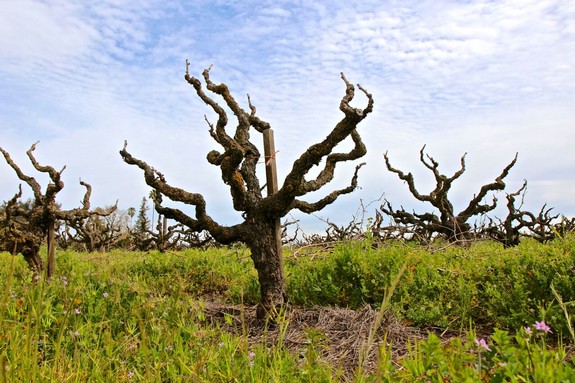
Classic 8-spur head trained vine in Burness Vineyard on the east side of Lodi's Mokelumne River AVA
In the 1850s and 1860s, when pioneering growers first began planting wine grapes in Sonoma County, Napa Valley, the Santa Cruz Mountain area, Amador County and, of course, the Lodi Viticultural Area, they planted their vines as free-standing plants – with no trellis wires, just one supportive stake per vine – in a fashion known as "gobelet."
Gobelet literally translates as “goblet,” in reference to the virtual shape of the vine: classically, a trunk topped at no more than a foot or two from the ground, crowned by eight (give or take) “spurs,” which are shortened canes kept as permanent arms positioned around the top (i.e. “head”) of the trunk. In this style of cultivation – said to date back to the ancient Egyptians and Romans yet still commonly practiced throughout Southern France and Spain – most of each year’s growth is pruned back during winter months, leaving buds or nodes at the top of each spur for the growth of typically two new canes in early spring.
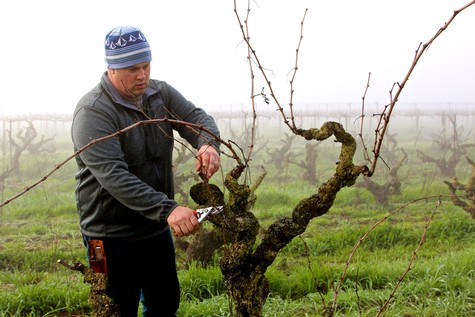
Tegan Passalacqua pruning his Kirschenmann Vineyard, leaving buds for spring growth of 2 canes at the tip of each spur
Hence, the old European gobelet system is better known as “head trained spur pruned” vines here on the West Coast. In the Southern Hemisphere, the term “bush vine” is commonly used since, of course, vines trained in this way resemble small bushes or shrubs.
It is still possible to see surviving blocks of California’s earliest plantings of head trained vines in the vicinity of Amador County’s Shenandoah Rd. just outside of Plymouth: particularly in Deaver Ranch’s blocks of Mission grape (magnificent old vines planted in 1853, just 5 years after gold was first discovered at Sutter’s Mill) and Zinfandel (dating back to the 1870s). Nearby is the venerated Original Grandpère Vineyard, where you find own-rooted Zinfandel planted in 1869. Further up the hill near Fiddletown, there are Mission vines in Rinaldi Vineyard planted around 1865, plus Zinfandel planted shortly thereafter. These ancient vines are like living (and still cranking!) museums.
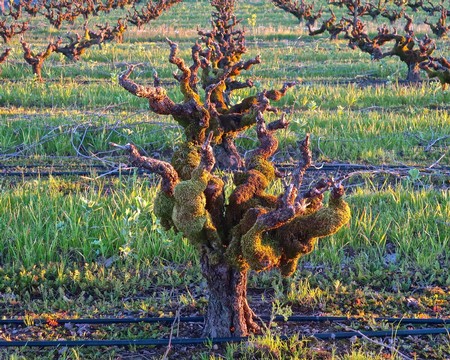
Mossy traditionally head trained spur pruned Zinfandel in Russian River Valley's Papera Vineyard (planted 1934)
Although during the past three winters the Lodi appellation has lost hundreds of acres of these old school head trained vines – most of them planted ungrafted, on their own rootstocks, prior to the mid-1960s – as the market for White Zinfandel and “jug” priced red Zinfandel (bottles under $12) has diminished, there are still thousands of acres of head trained spur pruned vines, very much commercially productive, cultivated in the region.
The oldest of Lodi’s head trained Zinfandel plantings date back to 1889: the Royal Tee Vineyard, first planted by Joseph Spenker in what is now known as Jessie’s Grove. Royal Tee is a mixed block of mostly Zinfandel inter-planted with Carignan, Mission, Tokay and Black Prince (the latter, also identified as Rose of Peru). The next oldest Zinfandel plants can be seen at the 75-acre Peirano Estate just south of Peltier Rd. and west of Hwy. 99 – vines first planted by Giacomo Peirano in 1896. Like Jessie’s Grove, Peirano Estate is still owned and farmed by their founders’ descendants.
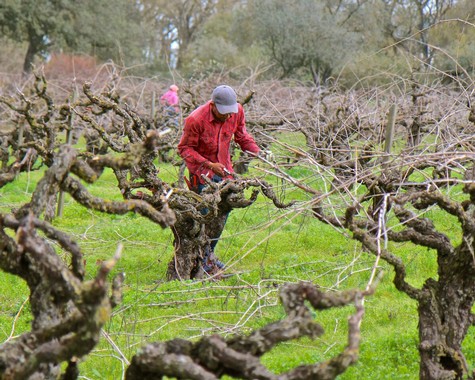
While nearly waist high and acquiring tree-like trunks at 130 years old, head trained vines in Jessie's Grove's Royal Tee Vineyard still maintains a goblet-like configuration
Over the past 130 years, however, what were originally classically small, gobelet trained vines in Jessie’s Grove have grown into much larger plants – most of them with spurs so long and trunks so wide, the growth has become almost tree-like, like bonsai gone wild. By way of contrast, Peirano Estate has maintained the traditional “tiny” sized gobelet style of vines (most with trunks less than a foot high) in their block of own-rooted Zinfandel. In addition, Peirano has also planted an extensive variety of other grapes (including Tempranillo, Syrah, Petite Sirah, Barbera, Malbec, Viognier, Sauvignon blanc and Muscat blanc), all cultivated in exactly the same traditional gobelet style – in tribute to the ancestral tradition as much as for the winery estate's own practical purposes and quality objectives.
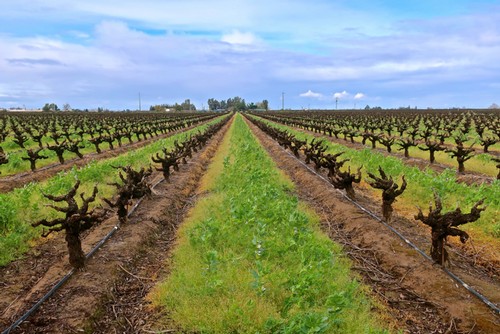
European style "small vine" gobelet trained Zinfandel (on 12-inch trunks) in the 75-acre Peirano Estate (west side of Mokelumne River-Lodi)
Historic and current value of head trained vines
As in Europe, there were multiple reasons for planting vines as head trained plants during the first 100 years of the California wine industry, including:
• The fact that it was easy and economical – especially in the case of own-rooted vines, which was just a matter of sticking cuttings into the ground and watching them sprout – in contrast to the consuming infrastructural work going into elaborate trellis systems.
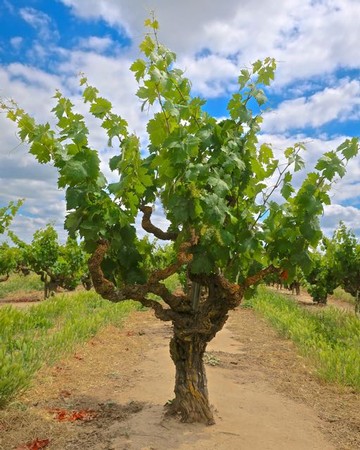
Marian's Vineyard Zinfandel (planted 1901) with late May growth
• Also as in Europe, head training in California has been supportive of smaller vines with their intrinsically limited vegetative growth, thus require little or no irrigation, and also successful in lower vigor sites (while at the same time, equally successful in the higher vigor – yet deep, well drained, sandy loam – soils of Lodi).
• As U.C. Davis' late, widely respected Dr. Jim Wolpert has pointed out, head trained fields were also conducive to cross-cultivation for weed control and water conservation during the days “prior to the availability of herbicides” and the irrigation systems available today.
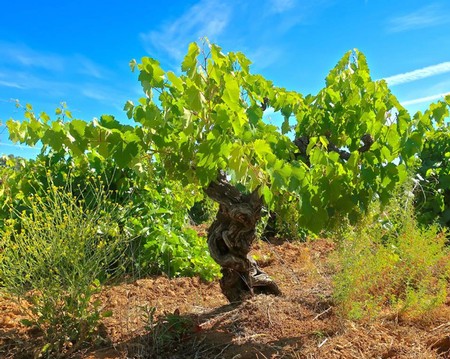
Soulful survivor: majestic Mission vine, planted in 1853 in Amador's Shenandoah Valley AVA, showing mid-July canopy (just prior to veraison)
• While requiring a certain degree of hand-work (particularly leaf pulling to alleviate mildew pressure and risk of rot), the “bushy,” umbrella-like canopies of head trained vines have proven particularly advantageous for thinner skinned black skinned varieties such as Zinfandel, a grape that is prone to sunburn; and for that reason, to this day most specialists of premium quality Zinfandel prefer fruit from head trained over trellised vines.
• Gobelet style viticulture has also proven conducive to other varieties playing key roles in California’s earliest grape growing history – particularly Carignan (always a workhorse grape in both Europe and California), Alicante Bouschet (highly favored during Prohibition years), Mataró a.k.a. Mourvèdre (known for its upright growing habit), Grenache a.k.a. Garnacha, Barbera, Petite Sirah, and especially in Lodi, Flame Tokay (Lodi’s most important grape product up until the 1970s) and Cinsaut. The world’s oldest Cinsaut planting happens to be found in Lodi’s oldest surviving vineyard, the 25-acre Bechthold Vineyard (trained as quasi-head trained/vertical cordons) planted by Joseph Spenker in 1886.
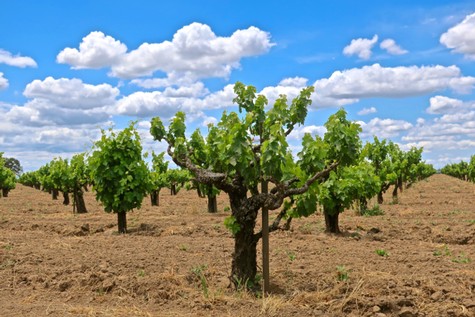
Bechthold Vineyard Cinsaut (Lodi's oldest vines, planted 1886) during mid-May, and trained on quasi-head trained/vertical cordons
Progressive Viticulture’s Stan Grant on gobelet pros and cons
Stan Grant, who has been furnishing viticultural advisory to grape growers in San Joaquin Valley for going on 30 years, recently published an industry-targeted article entitled Optimizing Head Trained Vineyards in Mid Valley Agricultural Services and lodigrowers.com.
According to Grant, it is the relatively uniform height of horizontally positioned spurs radiating “outwards and upwards from the head at the top of the trunk” that gives head trained plants a uniformity leading to “one of the key ingredients to exceptional winegrape quality.”
Another scientific reason why, according to Grant, gobelet systems have always worked: “The many twists and turns of the permanent woody framework and the vascular tissues within create resistances to the ascent of sap inside head trained vines. This may enhance their tolerance for water stress compared to vines trained more simply, like those formed as bilateral cordons.”
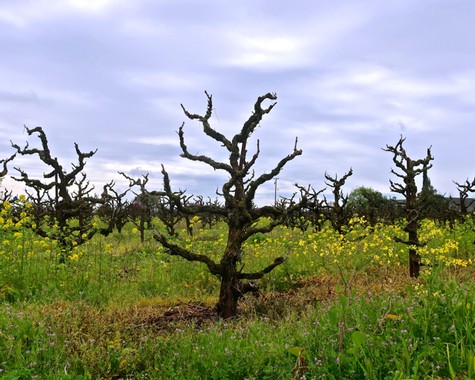
Not to be confused with "head trained" vines: Vertical cordon trained vine in L.W. Moore Vineyard (west side of Mokelumne River-Lodi)
It is also important, says Grant, to define exactly what a head trained vine is. He points out the differences, widely misunderstood, “between the goblet form of head training” and what is more correctly called “vertical cordons, which some in our industry mistakenly call head training.” According to Grant, vertical cordon trained vines “are simply trunks trained vertically onto a tall stake with arms and spurs located at intervals along their length.”
A large proportion of Lodi’s free-standing Zinfandel plantings – particularly those planted after the early 1960s, mostly on more vigorous rootstocks (such as Freedom and Dogridge) – are on vertical cordons, a style of planting that one local grower has described as a “layered cake” style of vine training. Says Grant, “While vertical cordon training is more expeditious and less labor intensive than gobelet training, it has a major inherent disadvantage.”
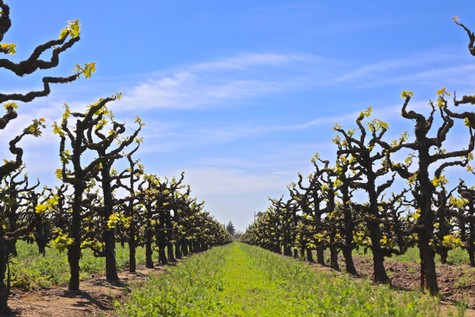
Early April growth on 6-ft. high vertical cordon trained Zinfandel in TruLux Vineyard (west side of Mokelumne River-Lodi)
Going into detail on why vertical cordon plantings are less conducive to consistent quality production than traditional gobelet training, Grant explains: “Grapevines display the apical dominance phenomena, in which organs, such as shoots, at higher positions acquire a greater share of vine resources at the expense of organs at lower positions. Consequently, shoots at higher positions on vertical cordons grow and develop more rapidly than those at lower positions... and the differences between higher and lower positions on vertical cordons become greater over time.”
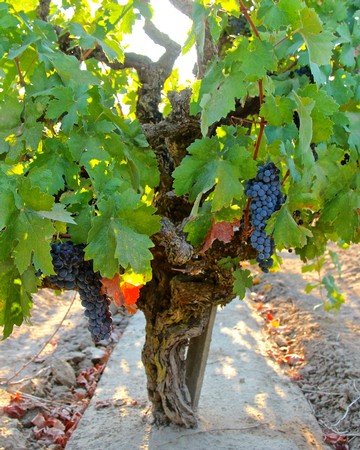
Vertical cordon trained Zinfandel of moderate height typical of Maley Bros.'s Wegat Vineyard (west side of Mokelumne River Lodi, planted on St. George rootstock in 1956)
All the same, there are a number of individual vertical cordon trained vineyards in Lodi that have forged stellar reputations for strongly distinctive wines: notably the acclaimed Bechthold Vineyard Cinsaut on Mokelumne River-Lodi's west side, the moderate sized vertical cordoned Zinfandel in Maley Bros.'s Wegat Vineyard on N. Ray Rd., the 6-ft. high Zinfandel vines in Maley on Lucas Rd. Vineyard (at W. Woodbridge Rd.), and the equally tall Zinfandel in Keith Watts’ TruLux Vineyard (the latter producing a string of McCay Cellars’ most consistent wines over the past 20 years).
Grant goes on to remark on the advantages of longer spurs and the increased height gained by gobelet style head trained vines as they mature: “Taller gobelet training reduces the risk of frost damage compared to shorter gobelet training. It also allows greater distances for shoots to drape before reaching the ground. The benefits of expanded shoot draping include greater exposed leaf area per vine and associated ripening capacity, reduced requirement of hedging to keep shoots off the vineyard floor, and with appropriate shoot thinning to conserve the shoot density set during pruning, increased fruit zone aeration and reduced foliar disease.”
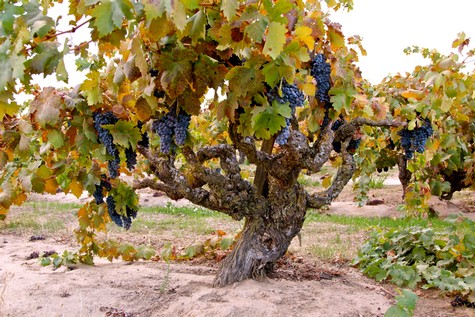
Fully mature, balanced head trained vine with expansive canopy in Kirschenmann Vineyard (own-rooted Zinfandel planted in 1915)
Among the disadvantages of head trained spur pruned vines, says Grant, are “limited fruit yields and poor adaptability to mechanization,” which in turn “limits head training to production of high priced winegrapes.“ Fortunately, adds Grant, a fully matured, balanced and properly managed gobelet shaped vine furnishes the ideal amount of canopy for the “dappled sunlight” that is ideal for the growth of high quality grapes and, ultimately, premium wines. These “viticultural attributes... (are) among the main reasons why many old head trained vineyards are highly valued in California.”
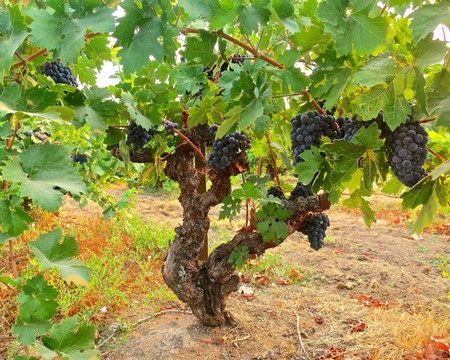
Very traditional, low-slung head trained vine producing small clusters in Süss Vineyard (own-rooted Clements Hills-Lodi Zinfandel planted in the 1920s)
Can head trained vines in Lodi survive today’s challenging economy?
In one of our past posts entitled The Gnarly Head Conundrum, Delicato Family Vineyards viticulturist Bud Bradley explained why ubiquitous yet stylistically driven products such as Gnarly Head Lodi Zinfandel (one could also include the hugely popular, Lodi grown 7 Deadly Zins and OZV Zinfandels to this conversation) will always be based on older head trained vines, as opposed to younger, more productive trellised plantings: "It’s only after vines reach a certain level of maturity – usually after about 35 years in the ground – that their arms (or spurs) become ‘gnarly,’ and more importantly, long enough to open up their (leaf) canopies so they have the exact right amount of shade and exposure to sunlight to ripen fruit without burning the Zinfandel fruit’s delicate skin, and enough air movement to resist rot during the later stages of ripening. That’s when a vine has settled into a perfect balance of moderate yield and superior quality.
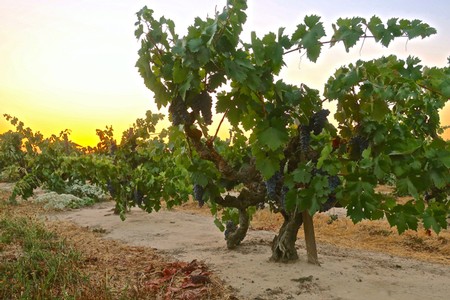
75-year-old head trained Mohr-Fry Ranch Zinfandel, nearing harvest in mid-August
“With younger vines on trellis, on the other hand, you have to do much more leaf thinning, dropping of fruit, shoot removal, and careful monitoring of irrigation just to achieve a balance of yield and quality that an older, head trained vines can produce naturally. Gnarly Head may retail for just $15, but we’re not willing to compromise on the standards of quality that have made it so popular to begin with.”
The drawback of this program, however, is the ever-increasing cost and shortage of labor to implement the work of pruning, leaf pulling, fruit dropping, and continuous reconfiguring of spur positions on head trained vines, which are far less amenable to more cost-effective mechanization than trellised plantings. According to Bradley, “One of the ways that we have begun planning for labor shortages has been through newer plantings of head trained vines that are trained up on sturdy stakes, which are connected by wires. This way they’ll be able to mature like classic old, head trained vines, but the wires will make it possible to mechanically harvest.”
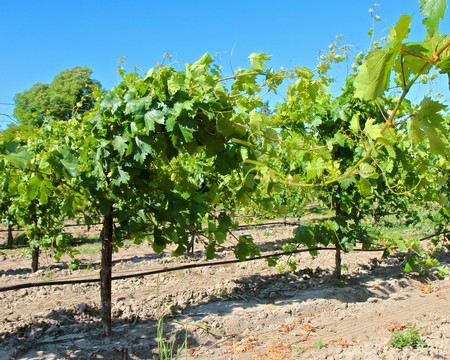
Newly planted head trained Mokelumne River-Lodi Zinfandel (5-year-old plants on slightly higher trunks) fitted with single-wire trellis and drip irrigation line
While DFV’s Gnarly Head Zinfandel program still relies almost exclusively on mature head trained as well as vertical cordon vines (from about 40 to 100 years old), the company has recently begun sourcing vineyards planted to head trained vines on a single wire trellis. Elsewhere in Lodi, you can find vineyards consisting of established, free-standing, vertical cordon trained plants that are being retrofitted with trellising involving as many as three vertical wires, increasing the potential for mechanical cultivation and picking.
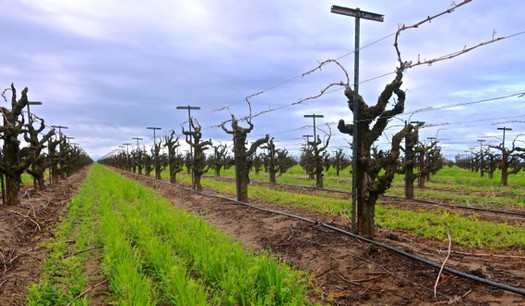
Vertical cordon trained vines retro-fitted with 3-wire trellis (west side of Mokelumne River-Lodi)
“Ancient vine” head trained Lodi plantings
For the record, here is a list of notable Lodi vineyards planted to head trained or spur pruned vertical cordon vines that are over 100 years old:
Bechthold Vineyard (Michael David, Turley, Onesta, Fields Family, McCay, Estate Crush, Jessie's Grove, and other wineries) – Cinsaut, planted 1886
Marian’s Vineyard (Mohr-Fry Ranches/St. Amant) – Zinfandel, planted 1901
Schmiedt’s 1902 Block (Michael Klouda) – Zinfandel, planted 1902
Charlie Lewis Vineyard (LangeTwins Family) – Zinfandel, planted 1903
Steacy Vineyard (Turley Wine Cellars) – Zinfandel, planted 1907
Rous Vineyard (Ironstone, Macchia and McCay) – Zinfandel planted 1909
Rauser Vineyard (Klinker Brick) – Carignan, planted 1909
Scottsdale Vineyard (Harney Lane) – Zinfandel, planted early 1900s
Kirschenmann Vineyard (Sandlands, Turley, and others) – Zinfandel, planted 1915
Lot 13 Vineyard (McCay Cellars) – Zinfandel, planted 1915
Soucie Vineyard (m2, Michael David and PRIE) – Zinfandel, planted 1916
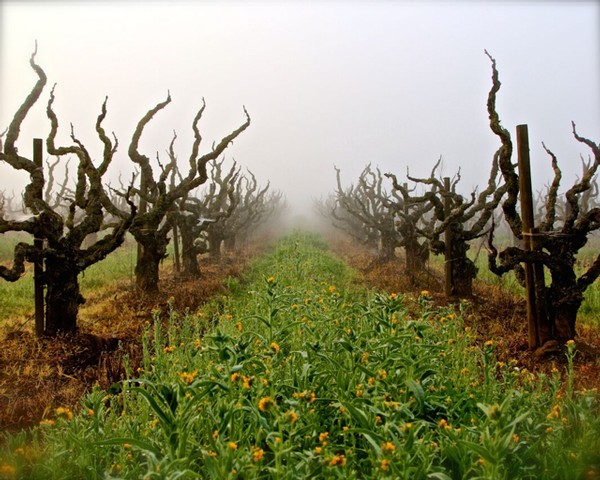
In February fog, very old vine Alicante Bouschet plants that have developed long and spidery spurs on more vertical trunks, adding up to a uniquely "Lodi" style of the traditional gobelet (west side of Mokelumne River-Lodi)